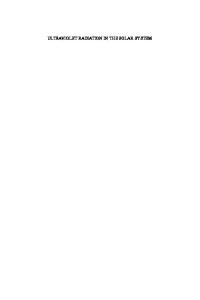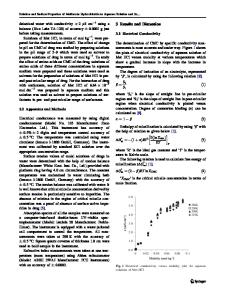Chemical actinometry and paraben decomposition in aqueous solution utilizing ultraviolet radiation combined with hydroge
- PDF / 1,324,435 Bytes
- 12 Pages / 595.276 x 790.866 pts Page_size
- 49 Downloads / 315 Views
ORIGINAL PAPER
Chemical actinometry and paraben decomposition in aqueous solution utilizing ultraviolet radiation combined with hydrogen peroxide Xavier Pierens1 · Viet‑Dung Nguyen1 · Thomas Lauzier1 · Karim Benhabib1 Received: 22 February 2020 / Accepted: 30 May 2020 © Institute of Chemistry, Slovak Academy of Sciences 2020
Abstract In this paper, ultraviolet radiation combined with hydrogen peroxide is presented to investigate the degradation of methyl, ethyl, and propyl parabens. The proposed kinetic model incorporates photochemical, chemical reactions, and reaction-rate constants to formulate the overall kinetic rate expressions, which are integrated into MATLAB. Thus, the chemical actinometry has been investigated to identify the incident ultraviolet-light intensity (1.59 × 10−6 Einstein.cm−1 s−1) and the optical path-length (5.83 cm) of the new reactor. Based on the optimal parameters of the previous study, an experimental campaign was performed at fixed hydrogen peroxide concentration to compare the half-life of the decomposition of these parabens and to determine the evolution of the pH and the pseudo-first-order rate constant. Accordingly, the study provides a comparison between numerical results and experimental data. The use of hydrogen peroxide at 25 µM resulted in 80% removal of propyl paraben (10 mg/L) within 90 min reaction time, while 50% of methyl and ethyl was oxidized. The performed model had a satisfactory predictive performance of paraben removal during the reaction, and the numerical pseudo-first-order rate constant was in agreement with the experimental value. Although the proposed model slightly overestimates the decrease of experimental pH, it provides insight into the evolution of hydroxide, superoxide, and hydroperoxyl ions. Finally, this paper proposes a discussion on the limitations of the study and suggests future work concerning the effects of water matrix, carbonate species, paraben mixture, and cytotoxicity of degradation by-products. Keywords Chemical actinometry · Parabens · Ultraviolet radiation · Experimental data · Kinetic model · Rate constant
Introduction Parabens belong to the family of synthetic esters of p-hydroxybenzoic acid that are found in 80% of personal care products (Andersen 2008) such as cosmetic lotions, creams, sprays, and bath products. They are also used as plasticizers for some specific polymers in foodstuffs (Oishi 2002). Recently, Błędzka et al. (2014) have shown that the average daily exposure to parabens of 60 kg person weight Electronic supplementary material The online version of this article (https://doi.org/10.1007/s11696-020-01237-8) contains supplementary material, which is available to authorized users. * Viet‑Dung Nguyen vietdung.nguyen@u‑picardie.fr 1
EPROAD Research Unit, University of Picardie Jules Verne– IUT of Aisne, 48 Ostende Street, 02100 Saint‑Quentin, France
in the United States is estimated to be approximately 76 mg/ day (cosmetics and personal care products 50 mg/day, drugs 25 mg/day and food 1 mg/day). More than 77% o
Data Loading...










